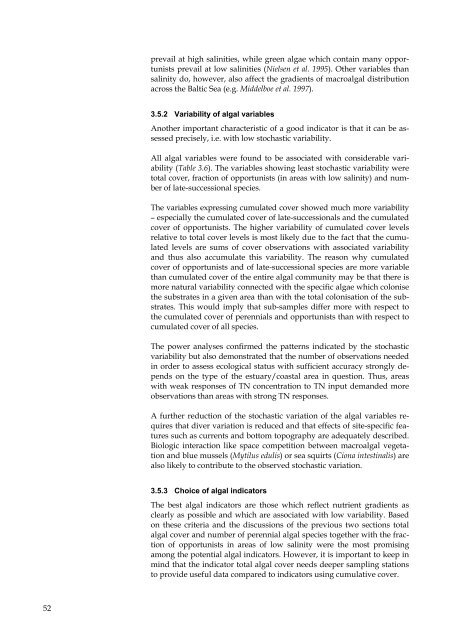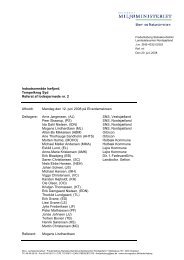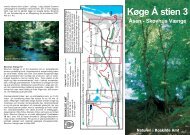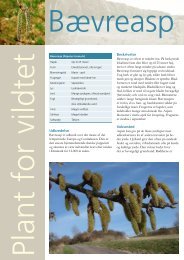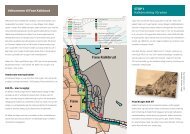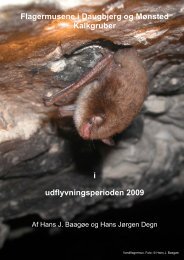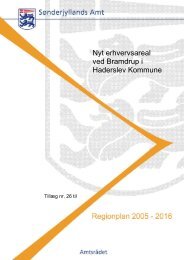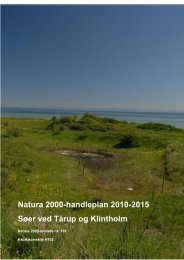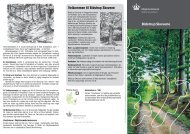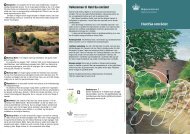Macroalgae and phytoplankton as indicators of ... - Naturstyrelsen
Macroalgae and phytoplankton as indicators of ... - Naturstyrelsen
Macroalgae and phytoplankton as indicators of ... - Naturstyrelsen
You also want an ePaper? Increase the reach of your titles
YUMPU automatically turns print PDFs into web optimized ePapers that Google loves.
prevail at high salinities, while green algae which contain many opportunists<br />
prevail at low salinities (Nielsen et al. 1995). Other variables than<br />
salinity do, however, also affect the gradients <strong>of</strong> macroalgal distribution<br />
across the Baltic Sea (e.g. Middelboe et al. 1997).<br />
3.5.2 Variability <strong>of</strong> algal variables<br />
Another important characteristic <strong>of</strong> a good indicator is that it can be <strong>as</strong>sessed<br />
precisely, i.e. with low stoch<strong>as</strong>tic variability.<br />
All algal variables were found to be <strong>as</strong>sociated with considerable variability<br />
(Table 3.6). The variables showing le<strong>as</strong>t stoch<strong>as</strong>tic variability were<br />
total cover, fraction <strong>of</strong> opportunists (in are<strong>as</strong> with low salinity) <strong>and</strong> number<br />
<strong>of</strong> late-successional species.<br />
The variables expressing cumulated cover showed much more variability<br />
– especially the cumulated cover <strong>of</strong> late-successionals <strong>and</strong> the cumulated<br />
cover <strong>of</strong> opportunists. The higher variability <strong>of</strong> cumulated cover levels<br />
relative to total cover levels is most likely due to the fact that the cumulated<br />
levels are sums <strong>of</strong> cover observations with <strong>as</strong>sociated variability<br />
<strong>and</strong> thus also accumulate this variability. The re<strong>as</strong>on why cumulated<br />
cover <strong>of</strong> opportunists <strong>and</strong> <strong>of</strong> late-successional species are more variable<br />
than cumulated cover <strong>of</strong> the entire algal community may be that there is<br />
more natural variability connected with the specific algae which colonise<br />
the substrates in a given area than with the total colonisation <strong>of</strong> the substrates.<br />
This would imply that sub-samples differ more with respect to<br />
the cumulated cover <strong>of</strong> perennials <strong>and</strong> opportunists than with respect to<br />
cumulated cover <strong>of</strong> all species.<br />
The power analyses confirmed the patterns indicated by the stoch<strong>as</strong>tic<br />
variability but also demonstrated that the number <strong>of</strong> observations needed<br />
in order to <strong>as</strong>sess ecological status with sufficient accuracy strongly depends<br />
on the type <strong>of</strong> the estuary/co<strong>as</strong>tal area in question. Thus, are<strong>as</strong><br />
with weak responses <strong>of</strong> TN concentration to TN input dem<strong>and</strong>ed more<br />
observations than are<strong>as</strong> with strong TN responses.<br />
A further reduction <strong>of</strong> the stoch<strong>as</strong>tic variation <strong>of</strong> the algal variables requires<br />
that diver variation is reduced <strong>and</strong> that effects <strong>of</strong> site-specific features<br />
such <strong>as</strong> currents <strong>and</strong> bottom topography are adequately described.<br />
Biologic interaction like space competition between macroalgal vegetation<br />
<strong>and</strong> blue mussels (Mytilus edulis) or sea squirts (Ciona intestinalis) are<br />
also likely to contribute to the observed stoch<strong>as</strong>tic variation.<br />
3.5.3 Choice <strong>of</strong> algal <strong>indicators</strong><br />
The best algal <strong>indicators</strong> are those which reflect nutrient gradients <strong>as</strong><br />
clearly <strong>as</strong> possible <strong>and</strong> which are <strong>as</strong>sociated with low variability. B<strong>as</strong>ed<br />
on these criteria <strong>and</strong> the discussions <strong>of</strong> the previous two sections total<br />
algal cover <strong>and</strong> number <strong>of</strong> perennial algal species together with the fraction<br />
<strong>of</strong> opportunists in are<strong>as</strong> <strong>of</strong> low salinity were the most promising<br />
among the potential algal <strong>indicators</strong>. However, it is important to keep in<br />
mind that the indicator total algal cover needs deeper sampling stations<br />
to provide useful data compared to <strong>indicators</strong> using cumulative cover.<br />
52


